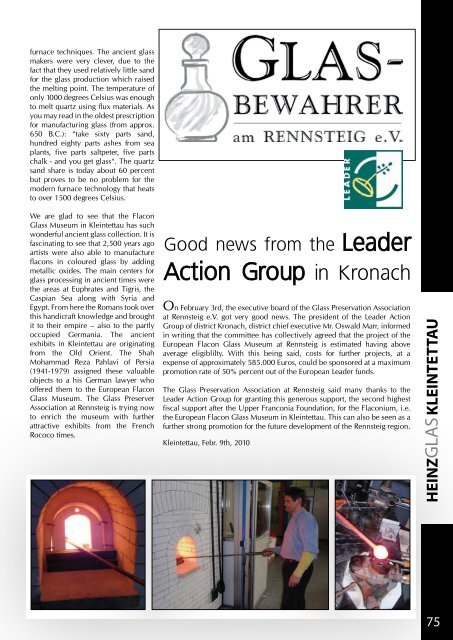78976013376073041739.pdf
78976013376073041739.pdf
78976013376073041739.pdf
Erfolgreiche ePaper selbst erstellen
Machen Sie aus Ihren PDF Publikationen ein blätterbares Flipbook mit unserer einzigartigen Google optimierten e-Paper Software.
furnace techniques. The ancient glass<br />
makers were very clever, due to the<br />
fact that they used relatively little sand<br />
for the glass production which raised<br />
the melting point. The temperature of<br />
only 1000 degrees Celsius was enough<br />
to melt quartz using flux materials. As<br />
you may read in the oldest prescription<br />
for manufacturing glass (from approx.<br />
650 B.C.): “take sixty parts sand,<br />
hundred eighty parts ashes from sea<br />
plants, five parts saltpeter, five parts<br />
chalk - and you get glass“. The quartz<br />
sand share is today about 60 percent<br />
but proves to be no problem for the<br />
modern furnace technology that heats<br />
to over 1500 degrees Celsius.<br />
We are glad to see that the Flacon<br />
Glass Museum in Kleintettau has such<br />
wonderful ancient glass collection. It is<br />
fascinating to see that 2,500 years ago<br />
artists were also able to manufacture<br />
flacons in coloured glass by adding<br />
metallic oxides. The main centers for<br />
glass processing in ancient times were<br />
the areas at Euphrates and Tigris, the<br />
Caspian Sea along with Syria and<br />
Egypt. From here the Romans took over<br />
this handicraft knowledge and brought<br />
it to their empire – also to the partly<br />
occupied Germania. The ancient<br />
exhibits in Kleintettau are originating<br />
from the Old Orient. The Shah<br />
Mohammad Reza Pahlavi of Persia<br />
(1941-1979) assigned these valuable<br />
objects to a his German lawyer who<br />
offered them to the European Flacon<br />
Glass Museum. The Glass Preserver<br />
Association at Rennsteig is trying now<br />
to enrich the museum with further<br />
attractive exhibits from the French<br />
Rococo times.<br />
Good news from the Leader<br />
Action Group in Kronach<br />
On February 3rd, the executive board of the Glass Preservation Association<br />
at Rennsteig e.V. got very good news. The president of the Leader Action<br />
Group of district Kronach, district chief executive Mr. Oswald Marr, informed<br />
in writing that the committee has collectively agreed that the project of the<br />
European Flacon Glass Museum at Rennsteig is estimated having above<br />
average eligiblilty. With this being said, costs for further projects, at a<br />
expense of approximately 585.000 Euros, could be sponsored at a maximum<br />
promotion rate of 50% percent out of the European Leader funds.<br />
The Glass Preservation Association at Rennsteig said many thanks to the<br />
Leader Action Group for granting this generous support, the second highest<br />
fiscal support after the Upper Franconia Foundation, for the Flaconium, i.e.<br />
the European Flacon Glass Museum in Kleintettau. This can also be seen as a<br />
further strong promotion for the future development of the Rennsteig region.<br />
Kleintettau, Febr. 9th, 2010<br />
HEINZGLAS KLEINTETTAU<br />
75


